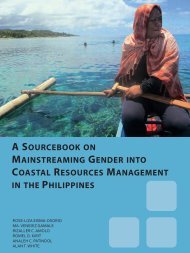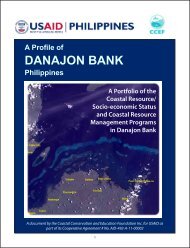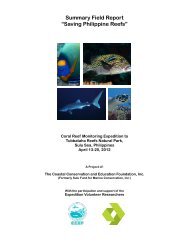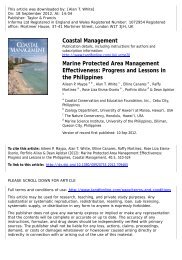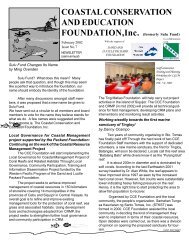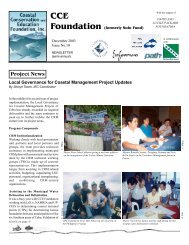Environmental Governance Project extends support to Siquijor to ...
Environmental Governance Project extends support to Siquijor to ...
Environmental Governance Project extends support to Siquijor to ...
You also want an ePaper? Increase the reach of your titles
YUMPU automatically turns print PDFs into web optimized ePapers that Google loves.
2EDITORIALDiversity of <strong>support</strong> and goodgovernance..........................2PROJECT NEWS<strong>Environmental</strong> <strong>Governance</strong><strong>extends</strong> <strong>support</strong>.................1MSN: A Social Networkaims <strong>to</strong> sustaining............3FPE elects CCEF asCommittee Member ........4IPOPCORM Ending .............4Batalang-Ba<strong>to</strong> MarineSanctuary...........................4SPR Expedition inBohol.................................5Prism Update: BuildingResponsible Families......5FEATURESGreenfest sa Sugbo............6Conservation Int’l <strong>Project</strong>:Establishing Partnershipsfor Coral Reef...................6<strong>Siquijor</strong> Provincial BantayDagat................................7CCE Foundation hosts PEWresearch...........................7MPA Feature...........................8Rotary Club signs MOA withCCEF....................................8CCE FOUNDATIONTIDBITSStaff Profiles.........................8New Publications................8Wishlist.................................8Edi<strong>to</strong>rs:Dr. Alan T. WhiteMrs. Evangeline WhiteAtty. Rose-Liza Eisma-OsorioLayout and Design:Mrs. Evangeline WhitePaula LozadaManaging Edi<strong>to</strong>r:Sheryll TeschDr. Alan T. WhiteEdi<strong>to</strong>rialDiversity of <strong>support</strong> and good governance are essential foreffective managementThis issue again highlights the diversity of activitiesneeded <strong>to</strong> <strong>support</strong> sustainable coastal managementprograms in the Philippines, or anywhere. Articles rangefrom environmental governance and reproductive health<strong>to</strong> progress in marine protected areas and building nationalnetworks of MPA practitioners. All these activities areessential <strong>to</strong> build long lasting and effective coastalmanagement.Nevertheless, although we are doing the right things, allis not well in some areas of our practice that offer poignantlessons. To draw from the report of the recent “SavingPhilippine Reefs” expedition <strong>to</strong> the Bohol Marine Triangle(BMT) area, we saw progress but also some distressingissues in this area where much attention has been focusedin recent years. To quote from the soon <strong>to</strong> be releasedreport:The results of our interviews with fishers, resor<strong>to</strong>pera<strong>to</strong>rs, people’s organization members, and barangayofficials regarding their perceptions documentmanagement and enforcement problems. Poachingallegedly occurs in most of the sanctuaries. In most MPAs,the lack of enforcement is perceived as a consequence ofpoor institutional <strong>support</strong> in providing honoraria <strong>to</strong>sanctuary wardens. The encroachment of commercialfishers in municipal waters continues <strong>to</strong> be a threat inBohol among others. Another important issue is the sizeand boundaries of the sanctuaries or core zones.Although all of the sanctuaries surveyed have boundariesthat <strong>to</strong>tally enclose the reef <strong>to</strong> some distance offshore, theactual boundary enforcement has wavered so that someboundaries only enclose the reef flat and not the entirereef crest and drop off where most reef fish reside. Ineffect, fishing is occurring within the intended core zonebecause of the poor placement of boundary markers.This recent development reflects a lack of strict adherence<strong>to</strong> the original municipal ordinances resulting in a wronginterpretation by the locals and <strong>to</strong>urists. As example, thesnorkeling line at the Balicasag MPA along the reef crestmay be confused by fishers as the MPA boundary andjustify their fishing on the reef slope.Data collected during the 2007 expedition compared withprevious surveys in 2003, 1997, 1995 and earlier forseveral sites showed declining trends in fish densitiesand biomass in most sites. This indicates a need <strong>to</strong>improve enforcement with stronger <strong>support</strong> from thelocal governments (LGs). To further draw from the BMT,it is recommended that:• MPA management conflicts are resolved amongmanagement groups and between stakeholdersso that MPA management groups areempowered.• Partnerships between LGs and communitygroups are strengthened and that LGs adoptthe MPA management plans developed withcommunity input.• Networking is initiated among MPAs withinthe BMT for management groups.• Simple and practical user-fee systems areimplemented with strong institutional<strong>support</strong>.• MPA boundaries are assessed and fixed <strong>to</strong>Municipal ordinance decisions.• Minimum size for all no-take sanctuaries inthe BMT is set at 10 hectares.• Education and awareness campaigns for thesanctuaries are continued.The observation that the offshore MPA boundariesenclose mostly the reef flat or crest and not the slope isworrisome because the primary benefits of the no-takesanctuary will be lost if this is the case. This isdetrimental <strong>to</strong> the fish s<strong>to</strong>cks inside the MPA since manyof the larger sizes of fish reside along the crest <strong>to</strong> slope.If the larger sizes are depleted, this will lead <strong>to</strong> a nonfunctionalMPA.Thus, we must always return <strong>to</strong> the basics of ourknowledge and experience <strong>to</strong> ensure that the quality ofour work on MPAs and other coastal management <strong>to</strong>olsis not eroded. For BMT, all is certainly not lost sinceseveral of the MPAs, namely Tawala and Balicasag, aredoing well, and the overall coral cover in most of thesanctuaries is stable or improved. Nevertheless, wecannot escape from the need for “diversity of <strong>support</strong>and good governance” <strong>to</strong> make our coastal managementsystems effective!Join or volunteer with CCE Foundation now if you want<strong>to</strong> contribute <strong>to</strong> this ongoing work on Philippine coasts!Board Members and AffiliationsPresidentDr. Alan T. White(Senior Scientist, Global Marine Initiative,The Nature Conservancy)Vice-President/TreasurerMr. William Jatulan(Deputy Chief-of-Party, Fisheries Improved for SustainableHarvest (FISH) <strong>Project</strong>)SecretaryMrs. Evangeline White(Finance Consultant, Community Conservation Network)CRM AdvisorDr. Patrick Christie(School of Marine Affairs, U. of Washing<strong>to</strong>n)Visayas AdvisorMrs. Rebecca Pestano-Smith(IEC Coordina<strong>to</strong>r, FISH <strong>Project</strong>)Community Work AdvisorMrs. Evelyn Deguit(Training Coordina<strong>to</strong>r, FISH <strong>Project</strong>)Institutional Development AdvisorDr. Thomas J. Mueller(Independant Educational Consultant)



